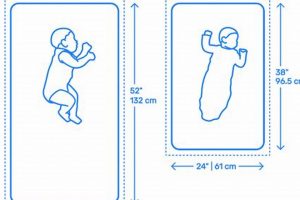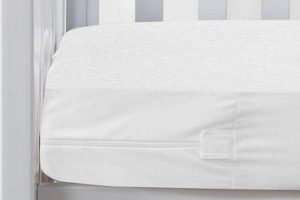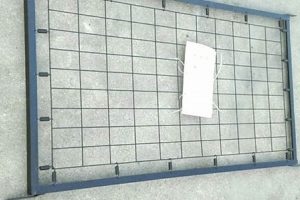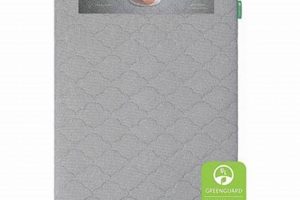A smaller-sized sleeping surface designed for infant beds, specifically those not adhering to standard crib dimensions, provides a safe and comfortable area for a baby to rest. These specialized products are essential when standard-sized mattresses are incompatible with the crib’s interior measurements. For instance, a compact or travel crib often necessitates a uniquely sized mattress to ensure a secure and properly fitted sleeping environment.
The advantage of using a properly sized mattress is the minimization of gaps between the mattress edge and the crib frame, which significantly reduces the risk of infant entrapment. This design feature contributes directly to creating a safer sleeping environment for the child. Historically, instances of injury related to ill-fitting mattresses have underscored the importance of precise sizing and adherence to safety standards in infant bedding.
The following sections will explore various considerations for selecting appropriate compact mattress options, including materials, safety certifications, and factors to consider when determining the appropriate size for a particular crib model. Understanding these elements ensures parents and caregivers can make informed decisions regarding their child’s sleep environment.
Considerations for Selecting a Compact Crib Mattress
The following guidelines are designed to assist in the selection of a properly sized infant mattress. Prioritizing these factors is essential for ensuring the safety and well-being of the child.
Tip 1: Measure Crib Interior Dimensions Accurately: Prior to purchase, obtain precise measurements of the interior length and width of the crib. These measurements are critical for determining the appropriate mattress dimensions. Discrepancies can lead to hazardous gaps.
Tip 2: Prioritize Mattress Firmness: A firm mattress is crucial for infant safety. Soft mattresses can increase the risk of suffocation. Verify that the selected mattress meets established firmness standards for infant sleep products.
Tip 3: Evaluate Material Composition: Carefully examine the materials used in the mattress construction. Opt for non-toxic, hypoallergenic materials that are free from harmful chemicals such as phthalates, lead, and flame retardants where possible. Look for certifications indicating material safety.
Tip 4: Check for Certifications: Verify that the mattress carries certifications from reputable organizations. These certifications indicate that the mattress has undergone testing for safety, emissions, and durability.
Tip 5: Inspect Seam Construction: Thoroughly examine the seams and edges of the mattress. Secure, well-constructed seams prevent the mattress from unraveling and ensure durability over time.
Tip 6: Consider Mattress Weight: The weight of the mattress can impact ease of changing linens. A lighter mattress can simplify this process; however, ensure that the weight does not compromise the mattress’s structural integrity.
Tip 7: Assess Waterproofing and Breathability: A waterproof surface is essential for hygiene and easy cleaning. Ensure that the mattress also offers sufficient breathability to promote airflow and reduce the risk of overheating.
By adhering to these recommendations, parents and caregivers can enhance the safety and suitability of the sleeping environment for infants using smaller cribs.
The subsequent section will address common questions and concerns related to compact crib mattresses.
1. Reduced Length
The defining characteristic of a “short crib mattress” is its reduced length compared to standard-sized crib mattresses. This dimensional alteration is not arbitrary but rather a direct response to the spatial constraints imposed by cribs designed with smaller footprints. The reduced length ensures the mattress fits securely within the confines of the compact crib, preventing gaps that pose a safety hazard to infants. This adaptability is paramount because standard mattresses, if forced into smaller cribs, would create potentially life-threatening situations by either bending and deforming, leading to uneven sleep surfaces, or by being altogether unusable.
The correlation between the reduced length and the intended use-case is therefore causal and critical. A manufacturer designing a travel crib, for example, would inherently specify a mattress of shorter length to match the crib’s inner dimensions. Conversely, if a caregiver attempts to use a mattress of standard length in such a crib, the consequences could range from an inability to assemble the crib correctly to the more serious risk of infant entrapment in the resulting gaps. Consequently, understanding the reduced length aspect is fundamental in ensuring compatibility and safety in infant sleeping arrangements.
In summary, the concept of “reduced length” is inextricable from the functionality and safety profile of a “short crib mattress.” It addresses the practical need for compatibility with smaller cribs, directly mitigating risks associated with improperly fitted mattresses. Recognizing this connection is essential for caregivers making informed decisions regarding infant bedding, thereby upholding the paramount goal of ensuring a safe sleep environment.
2. Narrower Width
The defining characteristic of “narrower width,” as applied to a “short crib mattress,” is a dimensional adaptation crucial for compatibility with cribs designed for limited spaces. This reduction in width, relative to standard-sized mattresses, is not merely an aesthetic alteration, but a functional necessity dictated by the internal dimensions of compact cribs.
- Space Optimization
A narrower width allows the mattress to fit into cribs where space is at a premium, such as in urban apartments, smaller nurseries, or when utilizing travel cribs. This optimization ensures that the crib, and consequently the sleeping infant, can be accommodated within the available area without compromising other essential functions of the living space. For instance, a bassinet-style crib might necessitate a narrower width to maintain its smaller overall footprint.
- Safety Compliance
Maintaining a snug fit within the crib frame is paramount for safety. A narrower width ensures that gaps between the mattress and the crib rails are minimized, preventing potential entrapment hazards. Regulations often stipulate maximum allowable gap sizes to prevent infants from becoming wedged in these spaces, underscoring the importance of precise mattress dimensions. Failure to adhere to these specifications could result in safety recalls or legal liabilities for manufacturers.
- Weight Considerations
A mattress with a narrower width typically translates to a lighter weight, which can be beneficial for portability, particularly in the context of travel cribs. This facilitates easier packing, transportation, and setup, making it more convenient for parents or caregivers on the move. While weight is not the primary factor determining mattress quality, it can influence the practical aspects of usability.
- Material Composition and Support
The reduction in width can affect the internal structure and support mechanisms of the mattress. Manufacturers must carefully consider the distribution of materials and the overall firmness to ensure that the mattress provides adequate support for the infant despite its reduced dimensions. Inadequate support could lead to discomfort or improper spinal alignment, highlighting the need for rigorous testing and design optimization.
In conclusion, the “narrower width” is not merely a scaled-down version of a standard crib mattress dimension. It is a design feature with significant implications for space utilization, safety, portability, and structural integrity. Understanding these interconnected elements is critical for selecting a “short crib mattress” that meets the specific needs of the intended crib and provides a safe and comfortable sleeping environment for the infant.
3. Safety Standards
The relationship between safety standards and a compact sleeping surface for infants is paramount. These standards are not optional but rather mandatory guidelines governing the design, materials, and manufacturing processes to minimize potential hazards. The effect of stringent safety standards on a compact mattress is that it is demonstrably safer for infants, reducing the risk of suffocation, entrapment, and exposure to harmful chemicals. The importance of these standards is amplified in non-standard-sized mattresses because deviations from typical dimensions might inadvertently introduce new safety challenges if not meticulously addressed. For instance, the Consumer Product Safety Commission (CPSC) sets federal safety standards for crib mattresses, including those specifically designed for compact or travel cribs. These regulations encompass flammability, lead content, and phthalate levels, necessitating compliance to protect infant health.
Real-world examples underscore the necessity of adherence to these standards. Recalls of infant mattresses due to excessive levels of flame retardants or inadequate firmness highlight the potential consequences of non-compliance. Independent testing and certification programs, such as those offered by ASTM International, provide an additional layer of assurance for consumers by verifying that the product meets or exceeds established safety criteria. These certifications validate that the manufacturer has subjected their products to rigorous testing and inspection processes, demonstrating a commitment to safety that extends beyond mere regulatory compliance. The practical significance of understanding these certifications lies in empowering parents and caregivers to make informed purchasing decisions, choosing products that demonstrably prioritize infant safety.
In summary, safety standards are an intrinsic component of a high-quality, secure compact mattress. They mitigate inherent risks associated with infant sleep environments and provide a framework for manufacturers to prioritize safety throughout the product lifecycle. The challenge for consumers lies in navigating the complex landscape of certifications and regulations, necessitating a proactive approach to research and verification. Ultimately, the goal is to ensure that any sleeping surface used for an infant, regardless of size, adheres to the highest standards of safety, promoting a safe and healthy sleep environment.
4. Firmness Level
The firmness level of a short crib mattress is a critical safety parameter directly impacting infant well-being. Insufficient firmness is causally linked to an elevated risk of Sudden Infant Death Syndrome (SIDS) and suffocation. A too-soft surface can conform to an infant’s face, obstructing airways and impeding breathing. Therefore, a firm mattress is not merely a comfort preference, but a necessary safety feature. The structural integrity of the mattress core, and the density of the materials used in its construction are key determinants of its firmness. The importance of firmness level in a short crib mattress is amplified because smaller mattresses might, due to their reduced dimensions, be perceived as inherently firmer; however, this is not necessarily the case, and diligent assessment is still required. Real-life cases of infants suffocating on overly soft mattresses highlight the tragic consequences of disregarding firmness standards.
Practical application of this understanding requires rigorous assessment during mattress selection. Parents and caregivers should physically test the mattress by pressing on its surface to gauge its resistance. The mattress should compress minimally under pressure and quickly return to its original shape. Furthermore, compliance with safety regulations, such as those established by the Consumer Product Safety Commission (CPSC), is paramount. These regulations stipulate minimum firmness requirements for crib mattresses, ensuring a baseline level of safety. Manufacturers should provide clear specifications regarding the firmness level of their products and offer certifications demonstrating adherence to relevant safety standards. The size (short crib mattress) is a factor that should be considered because smaller mattresses need the same consideration when evaluating the appropriate firmness.
In conclusion, firmness level is a non-negotiable aspect of a short crib mattress, essential for mitigating the risks of SIDS and suffocation. The challenge lies in consistently ensuring that mattresses meet or exceed established firmness standards, despite variations in size and construction. Parents and caregivers must prioritize this factor during the selection process, employing both physical assessment and verification of safety certifications. This understanding contributes to a safer sleep environment for infants, underscoring the critical role of informed decision-making in promoting infant well-being.
5. Compact Design
The term “compact design,” when applied to a crib mattress, denotes a deliberate reduction in size, specifically tailored to accommodate cribs with smaller interior dimensions. This design approach addresses practical considerations, such as space constraints in urban dwellings or the need for portability in travel environments, while simultaneously adhering to safety standards.
- Space Efficiency
Compact design maximizes available space by reducing the mattress’s footprint. This is particularly relevant in smaller nurseries or apartments where space is a premium. For instance, a mini-crib with a matching compact mattress allows for a functional sleep space without overwhelming the room. The reduction in size does not imply a reduction in essential functionalities, but rather an optimization of dimensions.
- Portability and Storage
A smaller mattress facilitates easier transportation and storage, making it suitable for travel cribs or temporary sleeping arrangements. Its reduced weight and dimensions simplify packing and handling. A foldable compact mattress further enhances portability, allowing for convenient storage when not in use. The design considerations focus on balancing practicality with maintaining a comfortable and safe sleeping surface.
- Material Optimization
The compact design necessitates careful consideration of materials to ensure adequate support and comfort within a smaller volume. Manufacturers optimize material density and composition to achieve the required firmness and durability. This might involve utilizing high-density foam or alternative materials that provide similar support characteristics in a reduced space. The objective is to maintain performance standards while minimizing overall size and weight.
- Safety Considerations
Despite the reduced dimensions, safety remains paramount. Compact design must not compromise safety features such as firmness, edge support, and material toxicity. Adherence to safety standards is crucial to mitigate potential hazards. The design must ensure a snug fit within the crib frame to prevent gaps that could lead to entrapment. Safety certifications are vital indicators of compliance with regulatory requirements.
The integration of compact design principles into the manufacturing of a “short crib mattress” reflects a commitment to both functionality and safety. By optimizing dimensions, materials, and structural elements, these mattresses cater to specific needs while maintaining essential performance characteristics. This design approach is essential for creating safe and efficient sleep environments for infants in various settings.
Frequently Asked Questions
The following addresses common inquiries regarding smaller mattresses designed for infant beds, aiming to clarify concerns and provide accurate information.
Question 1: What constitutes a “short crib mattress,” and how does it differ from a standard-sized option?
A smaller mattress is specifically designed for cribs with interior dimensions smaller than those of a standard crib. Typically, this refers to portable, travel, or mini-cribs. The key difference lies in the overall size; shorter mattresses are reduced in both length and width to ensure a proper and safe fit within these smaller crib frames.
Question 2: Are compact crib mattresses subject to the same safety regulations as standard-sized versions?
Yes, smaller mattresses are subject to the same safety standards and regulations as their standard-sized counterparts. These include flammability standards, restrictions on hazardous substances, and requirements for firmness. Compliance with these regulations is essential to ensure infant safety, regardless of the mattress size.
Question 3: How is the firmness level of these mattresses determined, and why is it important?
Firmness is evaluated through standardized testing to ensure it meets specific requirements. A firm surface is crucial to minimize the risk of Sudden Infant Death Syndrome (SIDS) by preventing the infant from sinking into the mattress, which could obstruct breathing. Guidelines dictate the appropriate firmness level for infant mattresses, irrespective of size.
Question 4: Can a standard-sized mattress be cut down to fit a compact crib?
Altering a standard mattress to fit a smaller crib is strongly discouraged. Cutting and resizing a mattress can compromise its structural integrity and potentially release hazardous materials. It also voids any safety certifications and could create unsafe sleeping conditions. A correctly sized mattress specifically designed for the crib is the only recommended option.
Question 5: Where can one locate certifications confirming the safety and non-toxicity of these mattresses?
Certifications, such as those from Greenguard Gold or CertiPUR-US, indicate that a mattress has been tested for chemical emissions and material safety. These certifications are typically displayed on the product packaging, the manufacturer’s website, or on a tag attached to the mattress itself. Verification of these certifications is a crucial step in ensuring the product’s safety.
Question 6: What is the expected lifespan of a compact crib mattress, and how should it be properly maintained?
The expected lifespan of these mattresses is generally similar to that of standard-sized versions, depending on the quality of materials and construction. Regular cleaning according to the manufacturers instructions, including wiping down the surface and using a waterproof mattress protector, can extend its lifespan. Check regularly for signs of wear or damage, and replace the mattress if any are detected.
Key takeaways from these questions highlight the importance of safety compliance, appropriate firmness, and avoiding alterations to existing mattresses. Proper size selection, certification verification, and consistent maintenance are essential for creating a safe sleep environment.
The next section will delve into specific recommendations for selecting and purchasing a suitable compact crib mattress based on individual needs and circumstances.
Concluding Remarks
The preceding discussion has explored various facets of the “short crib mattress,” emphasizing its unique characteristics, safety implications, and selection criteria. The objective has been to provide a comprehensive understanding of these specialized infant bedding products, highlighting the importance of adherence to safety standards and informed decision-making. Key considerations include precise sizing, material composition, firmness level, and certification verification, all of which contribute to a secure sleeping environment.
Given the inherent vulnerabilities of infants, the selection of a “short crib mattress” requires meticulous attention to detail and a commitment to prioritizing safety above all else. Continued vigilance and adherence to established guidelines are essential to safeguard infant well-being. It is imperative that caregivers remain informed and proactive in ensuring the creation of a safe and nurturing sleep environment for the youngest members of society.





![Lullaby Earth Crib Mattress: Safe, Certified [Sleep] Organic & Natural Mattress Buyer’s Guide: Non-Toxic Sleep Solutions Lullaby Earth Crib Mattress: Safe, Certified [Sleep] | Organic & Natural Mattress Buyer’s Guide: Non-Toxic Sleep Solutions](https://mattressworldpa.com/wp-content/uploads/2025/07/th-1276-300x200.jpg)

